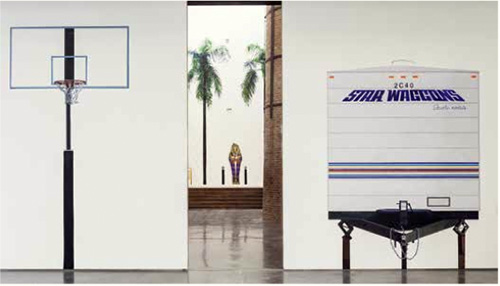THE LOS ANGELES PROJECT
| November 7, 2014 | Post In LEAP 29
THE LOS ANGELES PROJECT
ULLENS CENTER FOR CONTEMPORARY ART
2014.09.13~2014.11.09
Due to the structure of the Chinese art world, most of the international art that comes to Beijing arrives in the form of group exhibitions at the behest of private dealers and collectors. As a result, the works included in these exhibitions often seem to lack context or communication, occasionally to the point that the theme uniting them feels like an afterthought. Many such group shows end up feeling forced and stiff, as if they exist simply for the sake of putting on a show. But this is beginning to change.

Organized over the last two years by UCCA Director Philip Tinari and Chief Curator Paula Tsai, “The Los Angeles Project” is a group show featuring seven young artists from LA. The goal of the exhibition is as simple as it sounds: to give Beijing (and China as a whole) a taste of the current LA art scene. It follows on the heels of another international show, “Art Post-Internet,” held this past spring at UCCA, a group exhibition featuring artists from Western Europe and North America aiming to expose viewers in Beijing to one of the most active recent movements in Western art. Neither “Art Post-Internet” nor “The Los Angeles Project” alters their subjects to cater to local audiences; they are curated to best represent the original cultural likeness of the works they present. While this method is controversial, it confirms that Beijing is beginning to be treated as a cosmopolitan city. Perhaps more importantly, it shows that the international art community has faith in the Beijing art scene.
Unlike “Art Post-Internet,” which seeks to introduce and quote a new type of art, “The Los Angeles Project” highlights the cultural uniqueness of the American West Coast. Despite having only seven artists to illustrate the entirety of a city’s art scene, the exhibition succeeds because its artists are accurately representative and the show is tightly organized as a collection of small-scale exhibitions within a larger, cohesive whole. The exhibition is also complemented by a series of lectures, artist talks, and a film festival, culminating in a four-day “Los Angeles Art Weekend.” Along with touches like the series of individualized artist books released as a follow-up to the show, this makes the exhibition broad enough to satisfy any type of viewer. For visitors from across Beijing, it presents a lively and comprehensive introduction to the art, ambience, and attitude of Los Angeles.
Each of the seven artists in the show—Kathryn Andrews, Aaron Curry, Alex Israel, Matthew Monahan, Sterling Ruby, Ryan Trecartin, and Kaari Upson—is given his or her own space in the exhibition to showcase an individual style. Video artist Ryan Trecartin’s space, an immersive Lshaped room, is completely redesigned specifically for the show: different styles of seats are placed in front of each screen atop newly installed floorboards, while mirrors are hung in sections where walls meet in order to reflect the projections. The result effectively causes video, space, and audience to overlap and interact. Trecartin’s work, as in his previous sculptural theaters, distinctly and intensely portrays the confusion surrounding issues of identity and social reciprocity in the era of the internet. In a similar use of space, UCCA opens up its main hall for an iteration of Alex Israel’s site-specific mural project. The work is accompanied by an on-site dialogue with Hong Kong actor and entertainer Edison Chen, an addition to Israel’s celebrity interview series from his “As it LAys” videos. The integration of the mural and the interviews draws on the LA upbringing of the artist, whose work is often regarded as the archetype of Los Angeles style—an exaggeration of the celebrity worship and TV culture that abound in Hollywood.
This is, to some degree, the American art we are familiar with, but, while there is clearly space for exchange, this exhibition also argues for an increasingly dynamic and active landscape of Beijing art. Even if some of those at the opening are there for the famous names surrounding the event, the project shows that art can both reference and imitate celebrity and popular culture, including its power to inspire and exploit. In this right, “The Los Angeles Project” embodies an essential side of LA art.

